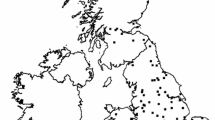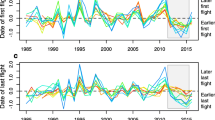Abstract
Quick studies on biodiversity are frequently used in conservation assessments. Conclusions from these studies would be consistent if assemblages under consideration are stable over time. The stability of butterfly assemblages in the Picos de Europa in northern Spain was examined at several levels of numerical resolution. The survey was carried out in 1993 and 1995, which allowed at least one complete turnover of all individuals in each locality. Butterfly assemblages were usually stable at the levels of number of species and total number of individuals, species presence and absence, and abundance rankings. But, absolute abundances of individual species changed from 1993 to 1995 out of synchrony with one another. Regional distributions and altitudinal ranges of species were also stable. Assemblages were similar in both study years, judging by similar site ordinations by reciprocal averaging. Overall, these results are in accordance with most studies where stability has been examined at several numerical levels; they also suggest that abundances of individual species do not vary enough to disrupt overall assemblage abundance rankings. Butterfly assemblages at sites at higher altitude tended to be more unstable in terms of abundance rankings and absolute abundances. This agrees with ecological theory predicting less stable assemblages in physically ‘harsh’ environments. We concluded that monitoring for a relatively short time period can give a clear picture of both local and regional butterfly biodiversity and species composition.
Similar content being viewed by others
References
Baroni-Urbani, C and Buser, M.W. (1976) Similarity of binary data. Syst. Zool. 25, 251–59.
Connell, J.H. and Sousa, W.P. (1983) On the evidence needed to judge ecological stability or persistence. Am. Nat. 121, 789–824.
Debinski, D.M. and Brussard, P.F. (1994) Using biodiversity data to assess species-habitat relationships in Glacier National Park, Montana. Ecol. Appl. 4, 833–43.
Ebeling, A.W., Holbrook, S.J. and Schmitt, R.L. (1990) Temporally concordant structure of a fish assemblage: bound or determined. Am. Nat. 135, 63–73.
Ehrlich, P.R. (1992) Population biology of checkerspot butterflies and the preservation of global biodiversity. Oikos 63, 6–12.
Erhardt, A. (1985) Diurnal lepidoptera: sensitive indicators of cultivated and abandoned grassland. J. Appl. Ecol. 22, 849–61.
Felicísimo, A.M. (1986) Parque Nacional de la Montaña de Covadonga. Introducción climática. Unpublished report, Universidad de Oviedo.
Gaston, K.J. (1994) Rarity. London: Chapman & Hall.
Gaston, K.J. and McArdle, B.H. (1993) Measurement of variation in the size of populations in space and time: some points of clarification. Oikos 68, 357–60.
Gaston, K.J., Quinn, R.M., Wood, S. and Arnold, H.R. (1996) Measures of geographic range size: the effects of sample size. Ecography 19, 259–68.
Gauch, H.G. Jr (1982) Multivariate Analysis in Community Ecology. Cambridge: Cambridge University Press.
Ghent, A.W. (1983) Tau as an index of similarity in community comparisons: an approach permitting the hypothesis of unequal species abundance. Can. J. Zool. 61, 687–90.
Gilbert, F.S. and Owen, J. (1990) Size, shape, competition, and community structure in hoverflies (Diptera: Syrphidae). J. Anim. Ecol. 59, 21–39.
Grossman, G.D. (1982a) Dynamics and organization of a rocky intertidal fish assemblage: the persistence and resilience of taxocene structure. Am. Nat. 119, 611–37.
Grossman, G.D. (1982b) Erratum. Am. Nat. 120, 699.
Grossman, G.D., Freeman, M.C., Moyle, P.B. and Whitaker, J.O. Jr (1985) Stochasticity and assemblage organization in an Indiana stream fish assemblage. Am. Nat. 126, 275–85.
Gutiérrez, D. (1997) Importance of historical factors on species richness and composition of butterfly assemblages (Lepidoptera: Rhopalocera) in a northern Iberian mountain range. J. Biogeogr. 24, 77–88.
Gutiérrez, D. and Menéndez, R. (1998) Phenology of butterflies along an altitudinal gradient in northern Spain. J. Zool., Lond. 244, 249–64.
Higgins, L.G. and Riley, N.D. (1983) A Field Guide to the Butterflies of Britain and Europe. London: Harper Collins.
Hill, J.K., Hamer, K.C., Lace, L.A. and Banham, W.M.T. (1995) Effects of selective logging on tropical forest butterflies on Buru, Indonesia. J. Appl. Ecol. 32, 754–60.
Joern, A. and Pruess, K.P. (1986) Temporal constancy in grasshopper assemblies (Orthoptera: Acrididae). Ecol. Entomol. 11, 379–85.
Jumars, P.A. (1980) Rank correlation and concordance tests in community analyses: an inappropriate null hypothesis. Ecology 61, 1553–54.
Kremen, C. (1992) Assessing the indicator properties of species assemblages for natural areas monitoring. Ecol. Appl. 2, 203–17.
Kremen, C. (1994) Biological inventory using target taxa: a case study of the butterflies of Madagascar. Ecol. Appl. 4, 407–22.
Lawton, J.H. and Gaston, K.J. (1989) Temporal patterns in the herbivorous insects of bracken: a test of community predictability. J. Anim. Ecol. 58, 1021–34.
Lepš, J. (1993) Taylor's power law and the measurement of variation in the size of populations in space and time. Oikos 68, 349–56.
Lewontin, R.C. and Felsenstein, J. (1965) The robustness of homogeneity tests in 2 × n tables. Biometrics 21, 19–33.
McArdle, B.H. (1989) Bird population densities. Nature 338, 628.
McArdle, B.H. and Gaston, K.J. (1992) Comparing population variabilities. Oikos 64, 610–2.
McArdle, B.H. and Gaston, K.J. (1993) The temporal variability of populations. Oikos 67, 187–91.
McArdle, B.H., Gaston, K.J. and Lawton, J.H. (1990) Variation in the size of animal populations: patterns, problems and artefacts. J. Anim. Ecol. 59, 439–54.
Meffe, G.K. and Sheldon, A.L. (1990) Post-defaunation recovery of fish assemblages in southeastern blackwater streams. Ecology 71, 657–67.
Nava, H. (1988) Flora y vegetación orófila de los Picos de Europa. Ruizia 6, 1–243.
Obeso, J.R. (1992) Geographic distribution and community structure of bumblebees in the northern Iberian peninsula. Oecologia 89, 244–52.
Owen, J. and Gilbert, F.S. (1989) On the abundance of hoverflies (Syrphidae). Oikos 55, 183–93.
Peterson, C.H. (1975) Stability of species and of community for the benthos of two lagoons. Ecology 56, 958–65.
Pimm, S.L. (1984) The complexity and stability of ecosystems. Nature 307, 321–6.
Pollard, E. (1977) A method for assessing changes in the abundance of butterflies. Biol. Conserv. 12, 115–34.
Pollard, E., Hall, M.L. and Bibby, T.J. (1986) Monitoring the Abundance of Butterflies 1976–1985. Peterborough: Nature Conservancy Council.
Rahel, F.J. (1990) The hierarchical nature of community persistence: a problem of scale. Am. Nat. 136, 328–44.
Rejmánek, M. and Spitzer, K. (1982) Bionomic strategies and long-term fluctuations in abundance of Noctuidae (Lepidoptera). Acta Entomol. Bohemoslov. 79, 81–96.
Rivas-Martínez, S., Díaz, T.E., Fernández, J.A., Loidi, J. and Penas, A. (1984) La Vegetación de la Alta Montaña Cantábrica. Los Picos de Europa. León: Ediciones Leonesas.
Ross, S.T., Matthews, W.J. and Echelle, A.A. (1985) Persistence of stream fish assemblages: effects of environmental change. Am. Nat. 126, 24–40.
Siegel, S. and Castellan, N.J. Jr (1988) Nonparametric Statistics for the Behavioral Sciences. New York: McGraw-Hill.
Sparrow, H.R., Sisk, T.D., Ehrlich, P.R. and Murphy, D.D. (1994) Techniques and guidelines for monitoring neotropical butterflies. Conserv. Biol. 8, 800–9.
Spitzer, K. and Lepš, J. (1988) Determinants of temporal variation in moth abundance. Oikos 53, 31–6.
Spitzer, K., Rejmánek, M. and Soldán, T. (1984) The fecundity and long-term variability in abundance of noctuid moths (Lepidoptera, Noctuidae). Oecologia 62, 91–3.
Spitzer, K., Jaros, J., Havelka, J. and Lepš, J. (1997) Effect of small-scale disturbance on butterfly communities of an indochinese montane rainforest. Biol. Conserv. 80, 9–15.
Ter Braak, C.J. and Prentice, I.C. (1988) A theory of gradient analysis. Adv. Ecol. Res. 18, 271–317.
Thomas, C.D. (1990) What do real population dynamics tell us about minimum viable population sizes? Conserv. Biol. 4, 324–7.
Thomas, C.D. (1991) Habitat use and geographic ranges of butterflies from the wet lowlands of Costa Rica. Biol. Conserv. 55, 269–81.
Thomas, C.D. and Hanski, I. (1997) Butterfly metapopulations. In Metapopulation Biology: Ecology, Genetics, and Evolution (I. Hanski and M.E. Gilpin, eds) pp. 359–86. San Diego: Academic Press.
Thomas, C.D. and Mallorie, H.C. (1985) Rarity, species richness and conservation: butterflies of the Atlas mountains in Morocco. Biol. Conserv. 33, 95–117.
Thomas, J.A., Moss, D. and Pollard, E. (1994) Increased fluctuations of butterfly populations towards the northern edges of species' ranges. Ecography 17, 215–220.
Townsend, C.R., Hildrew, A.G. and Schofield, K. (1987) Persistence of stream invertebrate communities in relation to environmental variability. J. Anim. Ecol. 56, 597–613.
Williamson, M. (1987) Are communities ever stable? In Colonization, Succession and Stability (A.J. Gray, M.J. Crawley and P.J. Edwards, eds) pp. 353–71. Oxford: Blackwell Scientific Publications.
Wolda, H. (1978) Fluctuations in abundance of tropical insects. Am. Nat. 112, 1017–45.
Wolda, H. (1980) Seasonality of tropical insects. I. Leafhoppers (Homoptera) in Las Cumbres, Panama. J. Anim. Ecol. 49, 277–90.
Wolda, H. (1988) Seasonality and the community. In Organization of Communities, Past and Present (J.H.R. Gee and P.S. Giller, eds) pp. 69–95. Oxford: Blackwell Scientific Publications.
Wolda, H. and Marek, J. (1994) Measuring variation in abundance, the problem with zeros. Eur. J. Entomol. 91, 145–61.
Wolda, H., Spitzer, K. and Lepš, J. (1992) Stability of environment and of insect populations. Res. Popul. Ecol. 34, 213–25.
Wolda, H., Marek, J., Spitzer, K. and Novák, I. (1994) Diversity and variability of Lepidoptera populations in urban Brno, Czech Republic. Eur. J. Entomol. 91, 213–26.
Yant, P.R., Karr, J.R. and Angermeier, P.L. (1984) Stochasticity in stream fish communities: an alternative interpretation. Am. Nat. 124, 573–82.
Author information
Authors and Affiliations
Rights and permissions
About this article
Cite this article
Gutiérrez, D., Menéndez, R. Stability of butterfly assemblages in relation to the level of numerical resolution and altitude. Biodiversity and Conservation 7, 967–979 (1998). https://doi.org/10.1023/A:1008885522377
Issue Date:
DOI: https://doi.org/10.1023/A:1008885522377




